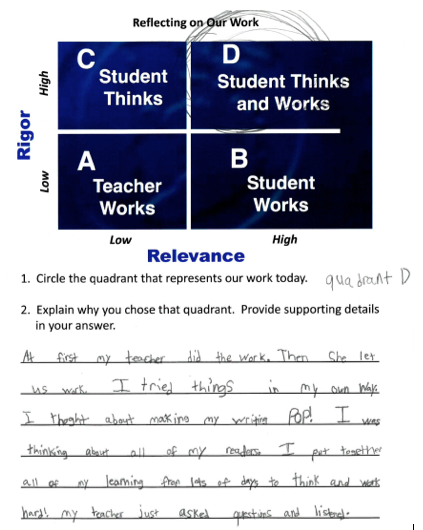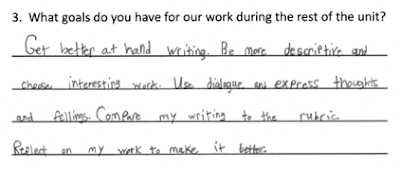Rigor and Relevance can seem like abstract terms until you start to understand how schools and districts apply them in specific ways. Over the past five years, we North Kansas City School District restructured our purpose so that student-centered learning was the ultimate objective. We put Rigor and Relevance in the foreground, along with several other initiatives. By committing to systematic integration of the model, we transformed the culture, the conversation, as well as the results in our district. Making our classrooms truly student-centered and relevant – thereby making real rigor possible – has allowed us to shape common beliefs for student success.
Here’s a little more about several key elements of our restructuring and their application of the Framework.
“Is this in the best interest of students?”
NKCSD positioned this powerful and grounding guiding mindset as the backdrop for all of our strategies and decisions. This principle helped continually focus our attention on initiatives that would successfully improve our district. We wanted a viable, research-based tool that would allow for collaboration regardless of hierarchy or prior knowledge. We found it in the Rigor/ Relevance Framework. To implement its use, administrators learned how to coach teachers in using it to design learning opportunities as well as how to gauge teacher impact on student achievement. We spent a year training teams of eight teachers from each school to become resident Framework experts who were responsible for replicating professional learning modules on their campuses. Using an early release schedule once a week allowed teachers to meet in teams to further their exposure and understanding of the Framework.
Spotting a Quadrant D Lesson from a Mile Away
As the entire district really became familiar with the Framework, its four quadrants became part of our everyday thinking around instruction and planning. We also developed an awareness of what constituted all of the quadrants and could identify how various lessons were targeted to address learning in each distinct quadrant. Teachers realized that they needed to apply qualities of each quadrant – and know why and when to do so – in order to create relevant and authentic tasks.
A Hidden Power of the Framework
Every teacher and administrator needs a simple, accessible, and readily-applicable way to talk about how learning can, and needs to, prepare students for life beyond the classroom. With just four quadrants, the Framework is a straightforward tool to consider and discuss student work and achievement. For teachers and administrators in the NKCSD, the Framework began to serve as the common language to describe exactly what it meant to ensure their students were college and career ready.
A Common Language = A Connected Culture
An additional benefit of deep integration of the Framework into common language was the elevated levels of effectiveness of the PLTs (Professional Learning Teams). Together they shared experiences and observations of the most and least effective instructional approaches and were able to collaboratively determine what kinds of tasks would lead to increased student learning.
As teachers began speaking the common language of the Framework, true, productive collaboration started to unfold. Numerous teachers grew more confident in their abilities, and mutually supportive relationships blossomed, which had a direct and noticeable impact on the quality of instruction and, hence, the student work emerging from the PLTs.
We also wanted pertinent stakeholders, including students and families, to know that the Framework was the linchpin to instructional decisions and goals. Teachers explained the Framework to students and families, making it known that students were expected to, with time, develop complex, Quadrant D thinking skills and the ability to apply high-level thinking to real-world scenarios. All students and their families were able to see how the district believed in their capability and potential, in specific and identifiable terms.
Students Truly Owning Their Work
One of the most significant impacts from implementing the Framework came with how teachers provided feedback and built collective ownership of learning. Sharing the Framework with students helped demystify learning goals, giving students powerful ways to self-evaluate, contextualize progress, and articulate goals.
One representation of the Framework in which a third grader analyzes how he spent his time as part of a writing block demonstrates real ownership of his learning.
The Framework naturally led to conversations in which students and teachers could both analyze and discuss work produced relative to the four quadrants. Instead of the “right or wrong” paradigm, the conversation shifted to the merits of student work and how it could stretch to other quadrants. Students and teachers were able to think about student achievement as a ladder accessible to everyone.
A Story of Improvement and Enrichment
In 2011, North Kansas City Schools had an Annual Performance Report in which the district earned only 78.9% of total points possible, the equivalent of a C in anyone’s grade book. By the 2013-14 school year, and after three years of total district adoption of the Framework, the significant improvements in collegial conversation and student work were reflected in a rating which had jumped to 92.1%. In the 2014-15 school year, we earned a 97.9% rating.
A highlight of the 2016 Model Schools Conference will be welcoming the North Kansas City School District leadership and hearing more about their implementation of the Rigor/Relevance Framework. Be sure to check them out on Twitter.


You need to be a member of School Leadership 2.0 to add comments!
Join School Leadership 2.0